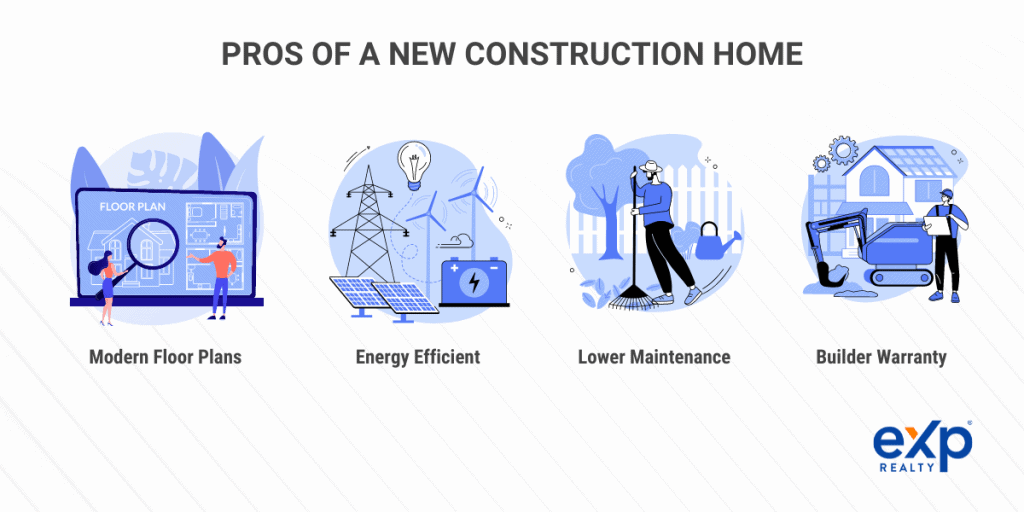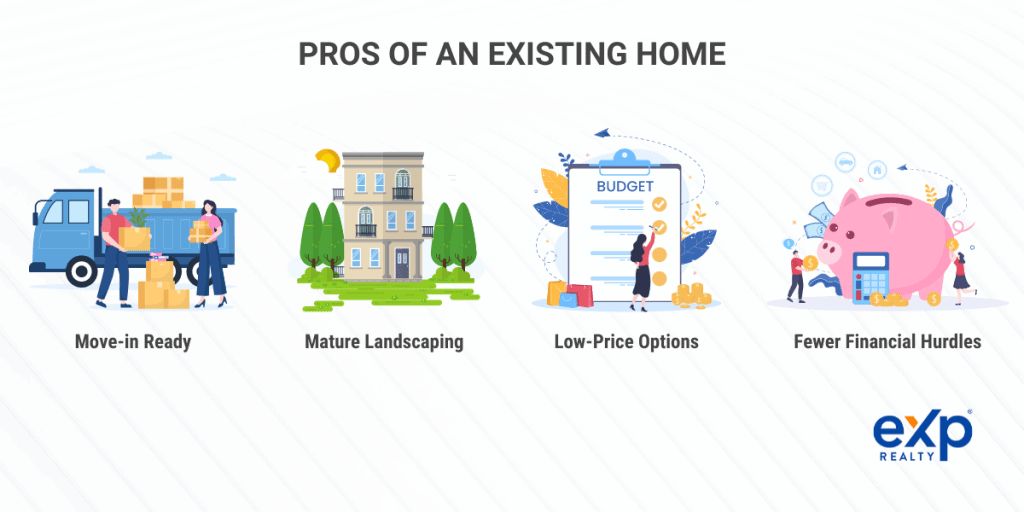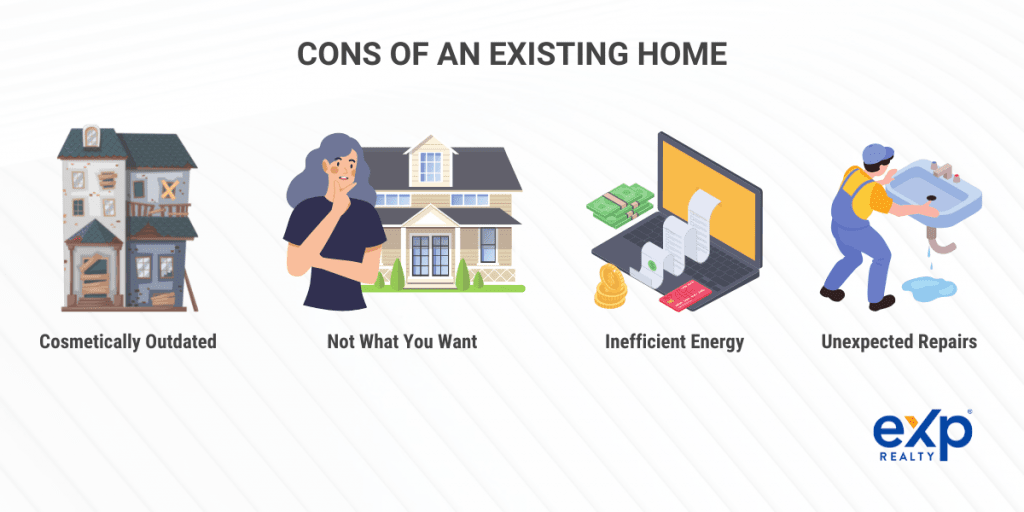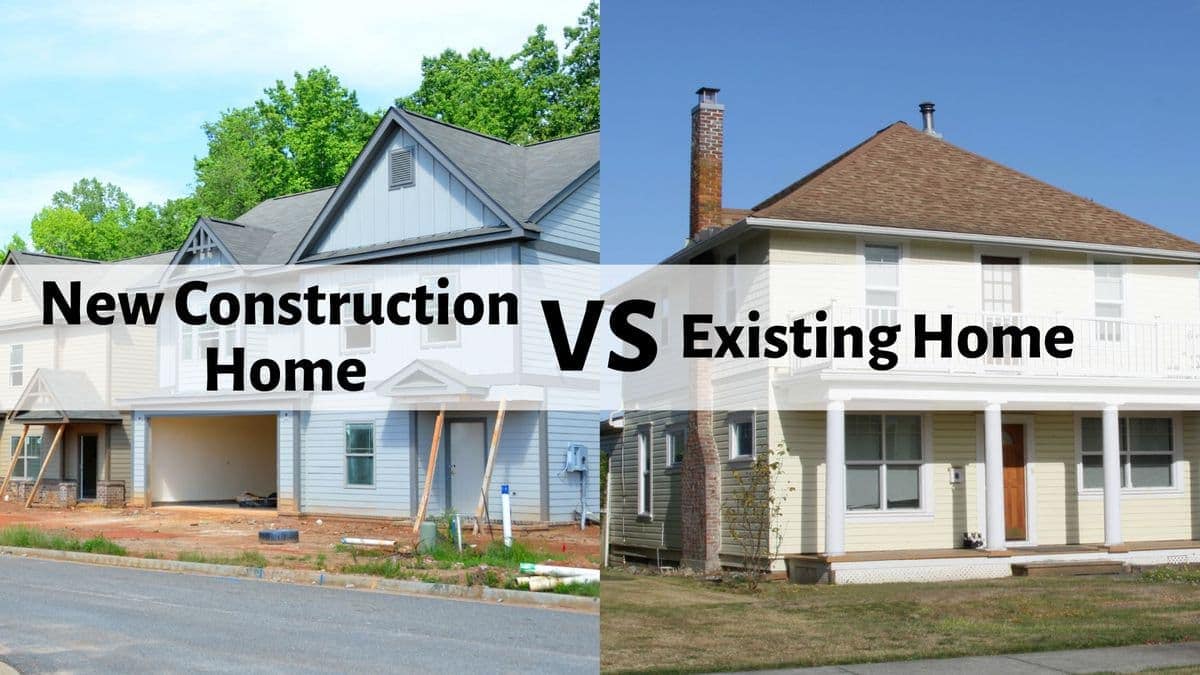When looking for a new home, some people choose to buy something existing, while others decide to build or buy a new home. If you’re wanting to live in an established neighborhood in Georgia, or buy a new construction home in Texas, continue reading to weigh the pros and cons of buying a new construction home vs. an existing home.
Pros of a New Construction Home

Modern Floor Plans
If you like seeing your living room, kitchen, and dining area all opened up to one another like in modern floor plans, more times than not you will find that in a new construction home. If you’re building a new construction home you can add in things like an office or a media room to the floor plan. Even if you bought a new construction home in Salt Lake City that’s near completion, with work from home jobs changing the home buying process, it’s likely to come with a designated office space.
Energy Efficient
The materials used to build homes over the decades have evolved. The types of materials used in the construction of a new home today are designed so that your home doesn’t use as much energy to maintain comfort and convenience. Things like the windows to the multiple layers on exterior walls like house wrap (Tyvek), polyseal foam, radiant barrier sheathing (Solarboard), and insulation are a few things that help keep the amount of energy being used at a minimum.
Lower Maintenance
Due to the nature of a new construction home, everything is brand new. This means that your appliances, HVAC, water heater, and other systems are working at their best and shouldn’t malfunction anytime soon. Aside from changing things like air and water filters, there isn’t much maintenance you have to keep up with in a new construction home.
Builder Warranty
Sometimes things do mess up though, and that’s where a builder warranty comes in. The specifics of a builder warranty may vary, but a builder warranty usually means the builder will cover or fix things on the home for about the first 10 years or so from when a home was built. You may not need to use the warranty, but it’s there as a precaution.
Cons of a New Construction Home

Unexpected Costs Upfront
When you build a new construction home, whether it be a custom home on your property or you buy from a builder in a master-planned community, there may be unexpected costs. The added costs could be due to things like inflation of material costs, like the lumber prices we saw in 2021, or simply not liking a paint color or tile floors and paying to get them changed to something different.
A smart lender may pad your loan just in case unexpected costs arise, but it doesn’t mean you’ll still have to pay the buffer back if you don’t end up using it.
Lack of Landscaping
This may not seem like a big deal at first, but whether you buy from a builder in a neighborhood or build on your own lot, the lack of landscaping can be a negative thing. For instance, if you’re building a custom home on your land, you have to pay for landscaping (even if it’s just sod). Since landscaping isn’t a necessity, oftentimes, this takes place after homeowners move in. The lack of landscaping can become a nuisance because mud and dirt are more likely to be tracked in the house.
It’s not as bad if you buy a new construction home in an HOA community, but it can still be negative. Usually, landscaping is required in these neighborhoods, but the landscaping isn’t mature and hardy yet. You won’t have the beautiful tree-lined streets and shade yet and the landscaping may need extra watering until the plants and trees take root.
Harder to Get Lending
Compared to buying an existing home, there are bigger hoops and more stipulations to obtain a construction loan. For example: One of the bigger hoops is you’ll need to have worked for the same employer for 2+ years, whereas if you’re buying an existing home the minimum requirement is 6+ months. The main reason is that you’re asking for money to buy something that doesn’t exist yet. To learn more about why it’s harder to get lending on a new construction loan, here’s an article explaining the types of construction loans.
The Wait and Moving Timeline
Whether you’re buying a new construction home that’s already near completion or starting from scratch, the timeline of events is not as cut and dry as if you’re buying an existing home. You can put a timeline together, but just know you’ll NEED to be forgiving when things don’t happen on time.
There are several factors that can hold up the production of your home. Things like the weather, materials on backorder, mistakes or changes, and subcontractors taking longer than expected on another job which causes them to reschedule when they can get to your home, are just a few things that can happen to cause the timeline to change and the wait being longer till you move in.
Pros of an Existing Home

Move-in Ready
Unless you’re buying a home that’s in desperate need of repair to be livable, more times than not, when you buy an existing home you’re buying a place that’s move-in ready. This can be beneficial for a couple of reasons: a relatively quick timeline (compared to building a home from scratch) from when your offer is accepted and easier to plan move-in dates.
Mature Landscaping
When buying an existing home, the landscaping is usually already established. Plus, if the previous owners were keen to impress, the landscaping may be in great shape at the time of your move-in. Depending on how old a home is, the trees may be big enough to provide shade and all the greenery has taken root so extra watering may not be necessary.
Low-Price Options
Unlike new construction homes, you can typically find existing homes at all price points. When you look at new construction homes, they’re already going to list for a certain price simply because they cost so much to build and everyone gets their cut of the money. For example, think about newer neighborhoods currently in development. You’ll see billboards and signs reading “starting from the $350s,” meaning every home in that community is at least that much and the price goes up from there.
Whereas, if you’re looking at existing homes that are a little older, you’re likely to find them at lower price points. They may need some cosmetic upgrades, but that may be worth it to you if saving is more important to you.
Fewer Financial Hurdles
Getting a mortgage loan has its hurdles, but not nearly as many as getting a construction-to-permanent loan. Just like we mentioned as a con to new construction, what makes financing easier to obtain for an existing home is that you’re asking for money to buy something that already exists. It’s less risky for the lender because, if a homeowner were to default on their loan, the mortgage company can use the home as collateral.
Cons of an Existing Home

Cosmetically Outdated
Unless an existing home is only a few years old or it was recently renovated, chances are what was trendy at the time it was built is no longer in style and the home is outdated. The functionality of the home may still be great but you’ll likely want to repaint, get new flooring, or more, which can cost you money out of pocket.
Not What You Want
When buying a new-to-you home, you’ll likely start out with a list of wants and needs, but as you journey through finding an existing home you’ll have a hard time finding a home that checks all the boxes. You’ll need to prioritize what’s most important to you and find something within that parameter, but even still you may have to compromise on one of those items.
Inefficient Energy
In the days before modern conveniences like electricity and central heating and air conditioning, homes were designed efficiently as possible. Windows and doors were strategically placed to allow airflow in the warmer months and fireplaces were centrally located to heat the whole house in the cooler months. With the invention of modern conveniences came the importance of making homes energy efficient by using as little electricity and propane as possible. Unless a home was built from the late ‘00s till now, it probably takes a lot of energy to heat and cool it, which means spending more on utility bills each month.
Unexpected Repairs
It’s likely a given that older homes require more attention, but that’s still a con. Even though you may expect repairs in general, what specifically breaks is still unexpected when it happens. It could be the A/C unit going out in the heat of summer to the water heater busting, or something simpler as a cabinet door breaking off from regular use over time. Whether you’re prepared and have money set aside for a rainy day or not, it’s still an inconvenience when things break and need repairs.
In addition, many states allow sellers to pick and choose what they disclose to home buyers, leaving the new homeowner with a checklist of expensive problems to fix. If this is the case, check out our article on what to do if you buy a home with undisclosed problems.
Should You Buy A New Construction Home or an Existing Home
We hope after reading this, you’ve come to a basic understanding of the difference between buying a new construction home vs. an existing home. If you’re wondering if you should build your own home or buy something existing, that depends on your season of life and what’s most important to you. Everyone is different so there is no one right or wrong way. Whether you choose one route or the other and need to buy land to build on or want to buy existing ones, be sure to get with a local real estate agent to help you through the buying process.





